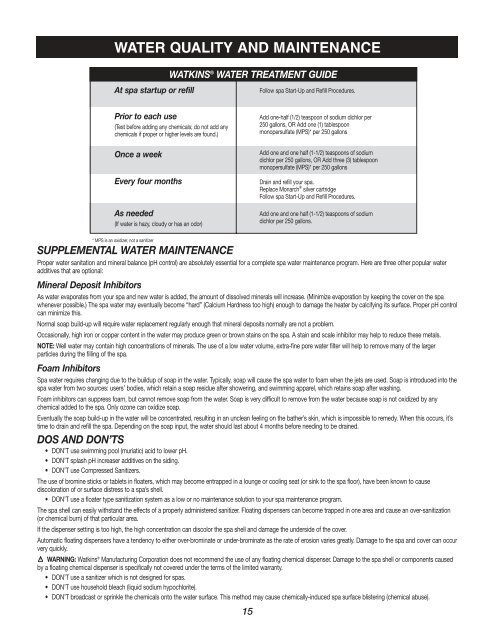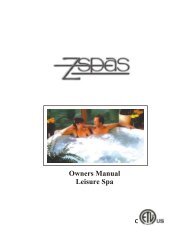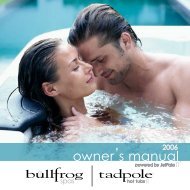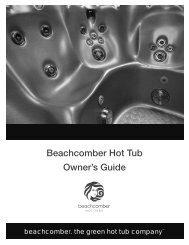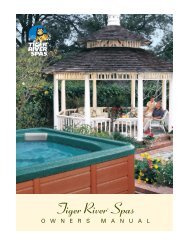Owner’s Manual
2006-2007 Oasis Series Owner's Manual - The Spa & Sauna Co
2006-2007 Oasis Series Owner's Manual - The Spa & Sauna Co
- No tags were found...
Create successful ePaper yourself
Turn your PDF publications into a flip-book with our unique Google optimized e-Paper software.
WATER QUALITY AND MAINTENANCE<br />
WATKINS ® WATER TREATMENT GUIDE<br />
At spa startup or refill<br />
Follow spa Start-Up and Refill Procedures.<br />
Prior to each use<br />
(Test before adding any chemicals; do not add any<br />
chemicals if proper or higher levels are found.)<br />
Once a week<br />
Every four months<br />
As needed<br />
(If water is hazy, cloudy or has an odor)<br />
Add one-half (1/2) teaspoon of sodium dichlor per<br />
250 gallons, OR Add one (1) tablespoon<br />
monopersulfate (MPS)* per 250 gallons<br />
Add one and one half (1-1/2) teaspoons of sodium<br />
dichlor per 250 gallons, OR Add three (3) tablespoon<br />
monopersulfate (MPS)* per 250 gallons<br />
Drain and refill your spa.<br />
Replace Monarch ® silver cartridge<br />
Follow spa Start-Up and Refill Procedures.<br />
Add one and one half (1-1/2) teaspoons of sodium<br />
dichlor per 250 gallons.<br />
* MPS is an oxidizer, not a sanitizer<br />
SUPPLEMENTAL WATER MAINTENANCE<br />
Proper water sanitation and mineral balance (pH control) are absolutely essential for a complete spa water maintenance program. Here are three other popular water<br />
additives that are optional:<br />
Mineral Deposit Inhibitors<br />
As water evaporates from your spa and new water is added, the amount of dissolved minerals will increase. (Minimize evaporation by keeping the cover on the spa<br />
whenever possible.) The spa water may eventually become “hard” (Calcium Hardness too high) enough to damage the heater by calcifying its surface. Proper pH control<br />
can minimize this.<br />
Normal soap build-up will require water replacement regularly enough that mineral deposits normally are not a problem.<br />
Occasionally, high iron or copper content in the water may produce green or brown stains on the spa. A stain and scale inhibitor may help to reduce these metals.<br />
NOTE: Well water may contain high concentrations of minerals. The use of a low water volume, extra-fine pore water filter will help to remove many of the larger<br />
particles during the filling of the spa.<br />
Foam Inhibitors<br />
Spa water requires changing due to the buildup of soap in the water. Typically, soap will cause the spa water to foam when the jets are used. Soap is introduced into the<br />
spa water from two sources: users’ bodies, which retain a soap residue after showering, and swimming apparel, which retains soap after washing.<br />
Foam inhibitors can suppress foam, but cannot remove soap from the water. Soap is very difficult to remove from the water because soap is not oxidized by any<br />
chemical added to the spa. Only ozone can oxidize soap.<br />
Eventually the soap build-up in the water will be concentrated, resulting in an unclean feeling on the bather’s skin, which is impossible to remedy. When this occurs, it’s<br />
time to drain and refill the spa. Depending on the soap input, the water should last about 4 months before needing to be drained.<br />
DOS AND DON’TS<br />
• DON’T use swimming pool (muriatic) acid to lower pH.<br />
• DON’T splash pH increaser additives on the siding.<br />
• DON’T use Compressed Sanitizers.<br />
The use of bromine sticks or tablets in floaters, which may become entrapped in a lounge or cooling seat (or sink to the spa floor), have been known to cause<br />
discoloration of or surface distress to a spa’s shell.<br />
• DON’T use a floater type sanitization system as a low or no maintenance solution to your spa maintenance program.<br />
The spa shell can easily withstand the effects of a properly administered sanitizer. Floating dispensers can become trapped in one area and cause an over-sanitization<br />
(or chemical burn) of that particular area.<br />
If the dispenser setting is too high, the high concentration can discolor the spa shell and damage the underside of the cover.<br />
Automatic floating dispensers have a tendency to either over-brominate or under-brominate as the rate of erosion varies greatly. Damage to the spa and cover can occur<br />
very quickly.<br />
WARNING: Watkins ® Manufacturing Corporation does not recommend the use of any floating chemical dispenser. Damage to the spa shell or components caused<br />
by a floating chemical dispenser is specifically not covered under the terms of the limited warranty.<br />
• DON’T use a sanitizer which is not designed for spas.<br />
• DON’T use household bleach (liquid sodium hypochlorite).<br />
• DON’T broadcast or sprinkle the chemicals onto the water surface. This method may cause chemically-induced spa surface blistering (chemical abuse).<br />
15


